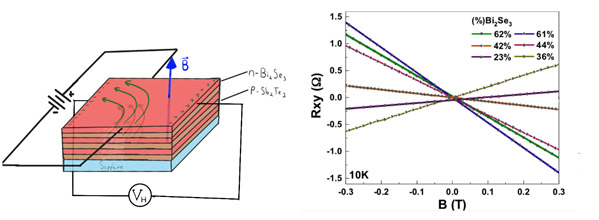Steven Alsheimer
Mentor: Professor Maria Tamargo, Chemistry
3-D Topological Insulators(TI) are materials that are resistive in the bulk yet maintain highly conductive 2-D surface states. The surface states in Bi2Se3/Sb2Te3 are protected via time-reversal symmetry leading to potential applications as spintronic devices, lossless transistors, and hosts of Majorana Fermions. There are practical problems with TI’s in actually growing bulk states that are resistive and have no carriers. Superlattices of p- and n- type materials are a potential way to overcome these problems. We present the properties of Bi2Se3/Sb2Te3 superlattices, and their potential for suppression of bulk carriers. We also present our particular and careful method of contacting samples necessary for meaningful measurements. A microtip soldering iron, set to certain temperatures, coupled with our technique ensures pinpoint ohmic contacts. Making contacts becomes more difficult with superlattices since some layers can be damaged. In order to maintain all the layers intact one cannot touch the sample with the iron, which led to the improved techniques. This study aims to investigate the transport of carriers of the bulk and surfaces of this material. The field dependent Hall resistance changes from n-type to p-type with the transition occurring at ~42% Bi2Se3. This is a promising sign of bulk carrier suppression. A weak anti-localization cusp in the magnetoresistance suggests the necessary preservation of topological surface states. These results indicate this is an excellent system for future studies on bulk state minimization through short-period superlattices.
a) b)
Figure 1: a.) A diagram depicting the Hall effect taking place on the Bi2Se3/Sb2Te3 superlattice. The Lorentz force directs the electrons to create a Hall voltage. b.) The results of the Hall measurements, showing a turning point from p-n type. A Bi2Se3 sample with 42% composition shows a very small slope.
Last Updated: 04/27/2018 12:19
